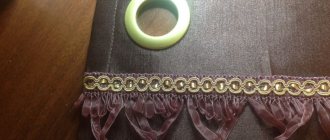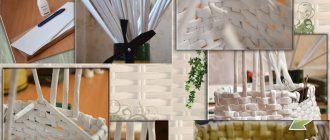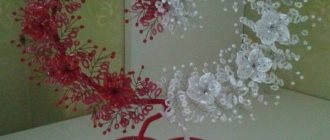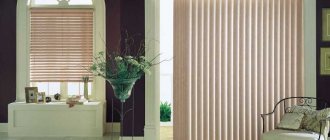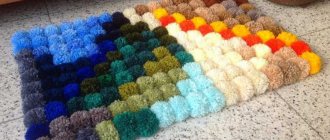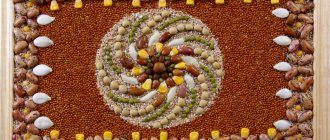What is macrame
Macrame is a well-known and popular all over the world method of needlework, the so-called knot weaving. Its essence lies in the fact that knots of different types and sizes are tied on a cord or thick yarn, in a certain sequence, and the result is the pattern you want.
Among the techniques that demonstrate the refinement of taste and skill of the needlewoman is macrame weaving.
Modern techniques have come to us from Ancient China, and mastering macrame is not as difficult as it might seem at first glance. As a result, the curtains turn out to be so spectacular that it is literally impossible to take your eyes off them. The main advantage is that you always have room for imagination, and no one forbids you to embody your own ideas.
Using the macrame technique, you can weave a huge number of original interior items, one of which is a curtain.
The main requirement for the material: the rope must be smooth and dense, and thickness, in the end, does not matter.
The rope can be nylon, cotton, hemp or other raw materials.
Laconic curtain using macrame technique
A decorative curtain made from ordinary rope can be an interesting way to decorate both a summer cottage and to separate the space inside a living space. Weaving cotton threads using the macrame technique is very easy, so our detailed photo master class is suitable for beginners too! This technique still remains popular due to the wide variety of working schemes designed for different levels of skill. Try your hand at this fascinating art!
For work we need:
1. Natural cord, art. ХБ6, 6 mm, natural (10 pcs.)
2. GAMMA tailor's scissors, art. G-303
3. Stick 100-110 cm
1. Attach a stick to the place where you plan to hang the curtain. Take 1 package of natural cord (art. HB6), remove the label, unwind and connect the 2 ends.
2. Holding both ends with your left hand, pinch them with your thumb and forefinger.
3. Let's walk our hand to the bend of the cord, aligning its two halves.
4. Let’s estimate the material consumption: cord thickness 6 mm x 2 cords = 120 mm; 120 mm x 20 cords = 240 mm = 24 cm. The distance between hanging cords is 3 cm x 19 times = 57 cm; 24 cm +57 cm = 81 cm – curtain width.
5. We will hang the threads on the stick according to the fastening scheme with a lock on the face (see diagram below): with our index finger we will throw the loop over the stick.
6. Place the ends of the threads into a loop.
7. And tighten it tightly.
8. For a curtain 81 cm wide, you need to hang 20 cords (there should be an even number) by fastening the threads with a lock on the face. The distance between the threads is 3 cm.
9. We will make the 1st row with a single left flat knot according to scheme No. 1.
Scheme No. 1 “Single left flat knot”
Let's take 4 threads in our hands
10. Fold the leftmost thread and place it on the two middle threads and under the rightmost thread.
11. Draw the right thread into the loop from the left outermost thread.
12. Hold the two middle threads with the fingers of your right hand.
13. Tie the outermost left and right threads into a knot so that the distance from the stick to the knot is equal to the width of the index and middle fingers.
14. Next, we’ll make a simple knot according to pattern No. 2 on two middle threads: put two middle threads on the palm of our left hand, and with our right hand we’ll bring the ends of the threads to the left.
Scheme No. 2 “Simple knot”
15. And we will drag them into the noose.
16. Tighten the knot and move it to the left single knot by the width of the index finger.
17. At the same distance we will make a second single left flat knot according to scheme No. 1.
18. Repeat this combination (single left flat knot, simple knot and single left flat knot) 9 more times.
19. We will weave the 2nd row with a double flat knot according to scheme No. 3, which consists of alternating single left and right (see diagram No. 4) straight knots.
Scheme No. 3 “Double flat knot”
Scheme No. 4 “Single right flat knot”
20. Weave the next row from right to left, skip 2 threads and take 4.
21. Let's make a single left flat knot according to scheme No. 1.
22. Pull it to the width of two fingers from the last knot of the 1st row.
23. Let's make a right flat knot according to scheme No. 4.
25. Weave double-sided left flat knots to the end of the row.
26. We will make the 3rd row from double-sided flat knots as follows: first we make a single right flat knot, then a single left flat knot. Take the first 4 threads and make a right single flat knot according to pattern No. 4.
27. Then we will make a left single flat knot according to scheme No. 1.
28. And let's tighten the knot.
29. Weave double-sided flat knots to the end of the row.
30. Measure the length of the threads to the desired height of the curtain and cut off the excess with GAMMA scissors (art. G-303); at the end of each thread you can tie a simple knot according to pattern No. 2.
Where to begin
If this type of needlework interests you, and you can’t wait to create “something like that,” first, familiarize yourself with the main types of macrame knots. There are few of them, and mastering them will not take you much time. Now you need to decide on the size of the future curtain and its pattern (diagram).
Products made using this method can decorate any interior, and you can even learn how to do it yourself.
You can start choosing the material. For beginners, it is better to avoid smooth, slippery ropes, since even skilled craftsmen have difficulty working with such material: the knot is difficult to fix and requires constant effort and control over compliance with the chosen pattern. But paper twine and a regular clothesline are an ideal option for a beginner.
Some time ago, knot weaving was undeservedly forgotten, but today it is experiencing a rebirth.
The main requirement for the material: it must be strong and elastic enough to securely fix the knot and prevent it from loosening or untying.
If you decide to start working with synthetic cord, then remember that the main disadvantage of this material is unraveling at the cut point, so do not forget to melt the edge.
With the help of macrame they make things of amazing beauty and elegance that will add originality and originality to any interior.
As a rule, it is difficult for novice craftsmen to immediately determine the amount of material needed, so it is recommended to purchase rope with a small reserve. Also, make sure you have the necessary equipment and tools, and don’t forget about decorative elements such as buttons, small appliqués, lace or ruffles.
In order to make beautiful macrame curtains, you don’t have to buy expensive fabric. They can be made from the simplest and completely inexpensive materials.
Required accessories:
- Centimeter, ruler for measurement;
- Scissors;
- Pins for fixation;
- Regular needles for sewing on decor;
- Crochet hook (often required if you need to untie an incorrect knot);
- Glue for fixing special units;
- A thick pad for attaching threads (some people prefer to use a special wooden frame for this purpose).
For the most comfortable work, any filler is fixed to a wooden base and sheathed with durable material. If the “upholstery” is checkered, this will significantly simplify the work process. If you choose a round pattern, then you can use a hoop as a base.
Almost any thread, twine or rope is suitable for weaving curtains. The main thing is that they have a high degree of curl, otherwise the pattern will not come out clear and prominent.
This is the most necessary, but the set of accessories may be slightly supplemented depending on the model and material you choose.
Do I need to choose complex schemes?
Many people think that if they choose complex macrame curtain patterns, the product will turn out more beautiful and elaborate, but, as practice shows, curtains with simple repeating weaving will look no less aesthetically pleasing. They will be tender and very cozy in appearance. And for beginners, too complex a pattern for weaving macrame curtains can simply discourage them from continuing such work. There are many photos with simple weaving available to you, start with them.
Here, for example, is an algorithm for creating a beautiful macrame curtain for a window, which will be decorated with beads. You can’t do without a wooden plank on which the threads will be attached. You will need 30 four-meter threads and the same number of eight-meter threads. Dividing the eight-meter ones in half, we fasten the four-meter ones on the bar between them.
We weave diamonds in the middle, using 36 middle threads, and from 12 along each edge we make a “frame” of chains with beautiful knots along the entire length of the curtain. We weave beautiful beads into the middle of the diamonds to make the curtain even more original.
Advantages and disadvantages of macrame curtains
Advantages
To be fair, it is worth noting that macrame curtains compare favorably with other hand-made options, such as knitted or crocheted curtains. And there are a number of explanations for this.
Firstly, hand-made macrame curtains combine perfectly with tulle or organza, creating a complete design of the window opening.
The macrame technique is attractive because everyone can choose the appropriate level of difficulty.
Secondly, such curtains can be used for both spacious rooms and small rooms. The main thing is to choose the right curtain size and pattern.
Thirdly, wicker curtains are more durable and wear-resistant. They are easy to attach and also easy to remove for cleaning or washing.
Do not forget that curtains will look great in the interior only if they are in harmony with the overall design of the room.
And a few more undeniable advantages:
- By creating macrame curtains with your own hands, you make the interior unique and inimitable;
- you can always create a model of the size you need, with the pattern you like, and with a certain degree of density;
- the openwork diffuses light well, which is very important for windows facing south or east;
- windows facing the north side, decorated with macrame curtains, let more light into the room and make it visually more spacious;
- Unlike thread curtains, macrame curtains do not tangle, which makes them easier to use.
Finally, knitting is a great way to relieve stress and have fun. So, not only the end result is important, but also the process itself.
The pattern and color of the threads should be selected based on the style direction and area of the room.
Flaws
There are also obvious “disadvantages” of models using the macrame technique:
- As a rule, macrame curtains are heavy, which means the fastening must be strong and reliable;
- Any products made from threads or yarn attract dust, which means regular cleaning is necessary;
- Such models are always in “demand” among children and animals; there is a risk of damage to the interior item;
- Creating a macrame masterpiece may take a lot of time, but rest assured, you will certainly be pleased with the result.
Wicker curtains are a unique interior decor that cannot be purchased in a store.
How to weave macrame curtains on windows
The kitchen can be decorated with a beautiful curtain using the macrame technique. This interior element will add comfort and mystery to the room. You can use absolutely any pattern to knit it, but we will provide you with a description of the simplest of them. It is not necessary to knit a full-length curtain for a window. You can knit a piece that is one-third the length of the frame, combining it with delicate tulle or leaving fringe on it all the way to the floor.
Lesson on knitting macrame curtains for the kitchen:
- Measure the distance from the ceiling to where the curtain will end. Multiply it by 6 times and measure 30 threads according to the resulting size.
- Attach the threads folded in half with pins to the base. You should have 30 groups of two threads.
- Divide the threads into two groups, step back 3-4 cm, and tie them into regular knots. You should have 15 groups of 1/2 threads.
- Tie columns from each group consisting of three square knots.
- Take 3 and 4 threads from the first column and 1 and 2 from the second, go down 4 cm and weave a double flat knot.
- Separate 3 and 4 threads of the second column, as well as 3 and 4 of the third, go down 4 cm and make a square knot. Knit the entire row in this manner.
- The next row begins with the first four threads from the left. Step back 4 cm from the square knot and perform the next square knot. Knit the entire row to the end. You should begin to see a grid with jumpers made of double simple nodes.
- Knit 2-4 more rows in this way.
- The remaining threads need to be shortened to size, the ends treated with PVA glue and left as a regular fringe or braided and decorated with beads at the ends.
- Now you need to remove the tailor's pins from the curtains and tie them to the rings or attach hooks.
Despite the simple production, such a curtain will favorably emphasize the originality of the interior of your kitchen. In addition to it, you can tie tiebacks from a chain of square knots.
Care instructions
By following simple care tips, you can significantly increase the service life of macrame curtains:
- Wash only with liquid detergents in the “hand wash” mode;
- Do not twist the canvas under any circumstances;
- Don't tie your curtains in a knot;
- If curtains are made of synthetic threads, dry only on a flat surface;
- To smooth, use a steamer or iron, and heat treatment should be carried out only through cotton fabric;
- If there are no greasy stains and you just need to get rid of dust, use a vacuum cleaner;
- If your macrame curtains have ornate patterns, take the fabric to the dry cleaner.
The pattern on macrame curtains should differ depending on which room they are used in: kitchen, bedroom or living room.
DIY macrame curtains: patterns and weaving options
There are many patterns that can be used to weave macrame curtains. They can be complex or completely simple. If you are just going to master the rope style, then do not try to start weaving right away with intricate elements; it is better to use brids from rep knots and simple and double flat knots.
When choosing a weaving pattern for a product, you need to decide in advance where it will be located. The tulle for the kitchen should have a more elegant and sophisticated appearance, and the curtains on the door should be heavy and dense.
It will not be difficult for a professional to come up with a curtain pattern on his own, but for a beginner it is better to resort to ready-made images. To decorate the product, it is better to use wooden beads to match the threads, small amber beads or fringe.
Varieties of knitted curtains
Before you start working on a product, answer yourself the question: for what purpose is the thing intended. Perhaps the curtain will serve solely as a decoration, and it should not meet any special requirements. Ultimately, the choice of material and model will depend on the answer to this question.
A wicker curtain will perfectly decorate the room. A composition trimmed with fringe will look impressive.
If you need a light translucent curtain that covers the window with one sheet, it is better to opt for a crocheted or knitted curtain. The technique can be anything. Curtains like “arch” look very impressive. Such models fill the room with light and visually make it more spacious.
On the Internet you can find photos that will help you choose the right style of macrame curtain model that fits perfectly into various interiors.
In cases where there is a need for a more functional option, that is, to provide protection from sunlight and prying eyes, choose denser options. It is important to avoid curtains that are too thick, as they look very heavy and cumbersome.
An ideal option for many rooms is two curtains that can be moved to the sides, freeing up the window. This option can be crocheted or made using the macrame technique.
Macrame curtains can be made with your own hands, even for those who are just taking their first steps in the art of weaving.
Remember that knitted curtains are inappropriate in loft, hi-tech or Empire style. Roman, Austrian, Italian and English curtains also “cannot withstand” such a neighborhood. And the laconic style will not be “friendly” with lace and ruffles.
Curtains made using the macrame technique are an interesting and unique option. By choosing the right materials and design, you can create a practical thing. The main thing is that the design of the window opening is in harmony with the interior design as a whole.
They will decorate the interior of any living space, make it more comfortable, marked with a unique “zest” of originality.
Macrame curtains on the door... How beautiful, and most importantly simple!
Sometimes you want to divide a room into functional zones, but do this with the help of a light, almost invisible detail. Or hide something from prying eyes behind an openwork curtain. In our case, it was a closet in the bedroom that had a sliding door; over time it broke and they did not restore it.
To keep the closet tidy and functional, the simplest solution was to add a curtain - macrame curtains, which will hide its contents.
A better option would be to add a curtain in a light color (white or cream), but keep it non-boring, interesting and add texture to the design. Therefore, a curtain made using the macrame technique from thin ropes was chosen. The technique of this weaving is quite simple; it is only important to master the basic knots. We will show you how to create a simple and beautiful part step by step.
Curtains Macrame
Tie four long strands together into a knot and secure it to the base with a pin. The bottoms of the two middle threads also need to be secured in place.
Take the rightmost thread and move it to the left side in front of the two middle threads. Then pass the left thread behind the middle threads and thread the end into the loop formed. Pull both threads tightly. Now you need to do the same step in reverse order. Take the left thread and pass it to the right over the middle threads. Bring the right thread behind the two middle ones and thread it through the loop. Pull these two strands tightly until they form a knot with the knot from the previous step. This is the hardest part! The remaining steps simply repeat the basic movements. Repeat steps 1-3 with the other four strands to make another knot right next to the first knot. Now take the two rightmost strands of the first group of threads to make a new group with the leftmost strands of the second group.
50 design options for macrame curtains in the interior
Macrame curtain “Scheherazade”
To weave the lambrequin curtain “Sheherizade” I used jute cord 4mm in diameter, almost white, and acrylic cord 3mm in diameter for the cornice and golden brown trim, 2 slats of 1m each. length, 2.5cm. in diameter, I cut all the threads for the lambrequin into 2.5 m. Except for the outermost 8 on the right and left. These threads are 3m long. They will be used for weaving straps
Weaving the main element of the “Minutes” or “Window” curtains
Curtain for a window or door
Options for weaving curtains for different curtain widths Pay attention to the middle element, its options for different curtain widths.
A diagram of the weaving of a curtain element and a calculation of the cut of the threads (I give the general diagram that my sister gave) then individual sections of the diagram with additional printed text, if you can’t read it on the diagram.
7 threads (14 ends) per 1 element. The middle of the petal is filled with finishing thread. For example, brown, red or blue, etc. Using the same threads we weave a berry in the center of the flower
Thread cut for curtain width 1m.
1,3,26,27 - 4 pcs. x 2=8pcs 4,5,6,7,25,24,23,22—1.80m—8pcs x=16 8 9 10 21 -20 19 -2.1m—6 x2 =12pcs 12,14,15, 16,17,18 -2.3m -6 x 2= 12 pcs. 11.13—2.4 (0.65/1.75 and 1.75/0.65)—2x2 = 4 pieces (cut so that 1 end is 1.75 m. and the other 0.65 m.) 15, 17——2.4((0.65/1.75 and 1.75/0.65) —2Х2=4 pcs 2, 28—1.7 (0.65/1.05 and 1.05/0 ,65)—2×2 =4 pcs For the middle element 7 pcs 1.5 m each For side earrings 40 m.
Cutting like this is very difficult for beginners. Therefore, I advise you to cut all threads at 2.5 m. And the ends, which then have to be cut off (the longer, the better), can be used in another way.
For the middle element: 7 pieces, 1.5 m each. For side earrings 40m
Hang the threads so that one end is 65 cm and the other 1.75 m, etc.
It goes approximately 80m more than the first option (about 310m). This is without fringe and harnesses.
Curtains, curtains, tulles - these are all integral parts of windows or doorways. These are things that perform not only an aesthetic function, but also protect, for example, on windows from excess cold.
There are thousands of video tutorials on the Internet that show you how to sew almost any type of curtain. Moreover, the craftsmen will tell you not only how to correctly cut and sew the edges, but also how to choose good fabrics to make it easier to work with them, especially for beginners.
So many varieties of this decor have already been invented, so many materials and models that it seems there is nothing to be surprised at. Various photo catalogs are full of colors, luxurious fabrics, lambrequins and much more.
But there is always something to be surprised by. And here comes a completely ancient way of needlework.
